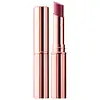What's inside
What's inside
 Key Ingredients
Key Ingredients

 Benefits
Benefits

 Concerns
Concerns

 Ingredients Side-by-side
Ingredients Side-by-side

Polybutene
Diisostearyl Malate
EmollientHydrogenated Polyisobutene
EmollientPolyethylene
AbrasiveVp/Hexadecene Copolymer
Microcrystalline Wax
Emulsion StabilisingMica
Cosmetic ColorantEthyl Vanillin
MaskingPentaerythrityl Tetra-Di-T-Butyl Hydroxyhydrocinnamate
AntioxidantPhospholipids
Skin ConditioningLimonene
PerfumingAroma
Hyaluronic Acid
HumectantSaccharomyces Cerevisiae Extract
Skin ConditioningSodium Chondroitin Sulfate
Skin ConditioningTocopherol
AntioxidantCitral
PerfumingDiamond Powder
AbrasiveDicalcium Phosphate
AbrasiveTripeptide-29
Skin ConditioningTin Oxide
AbrasiveCI 77891
Cosmetic ColorantIron Oxides
CI 15850
Cosmetic ColorantCI 19140
Cosmetic ColorantCI 15985
Cosmetic ColorantCI 42090
Cosmetic ColorantPolybutene, Diisostearyl Malate, Hydrogenated Polyisobutene, Polyethylene, Vp/Hexadecene Copolymer, Microcrystalline Wax, Mica, Ethyl Vanillin, Pentaerythrityl Tetra-Di-T-Butyl Hydroxyhydrocinnamate, Phospholipids, Limonene, Aroma, Hyaluronic Acid, Saccharomyces Cerevisiae Extract, Sodium Chondroitin Sulfate, Tocopherol, Citral, Diamond Powder, Dicalcium Phosphate, Tripeptide-29, Tin Oxide, CI 77891, Iron Oxides, CI 15850, CI 19140, CI 15985, CI 42090
Polybutene
Isostearyl Isostearate
EmollientHydrogenated Polyisobutene
EmollientPolyglyceryl-2 Tetraisostearate
EmollientHydrogenated Styrene/Methylstyrene/Indene Copolymer
Synthetic Beeswax
Emulsion StabilisingCaprylic/Capric Triglyceride
MaskingCalcium Sodium Borosilicate
Mica
Cosmetic ColorantStearalkonium Bentonite
Gel FormingSilica
AbrasiveAroma
Propylene Carbonate
SolventPentaerythrityl Tetra-Di-T-Butyl Hydroxyhydrocinnamate
AntioxidantDicalcium Phosphate
AbrasiveMentha Piperita Oil
MaskingTocopherol
AntioxidantCalcium Aluminum Borosilicate
Limonene
PerfumingButylphenyl Methylpropional
PerfumingTin Oxide
AbrasivePolybutene, Isostearyl Isostearate, Hydrogenated Polyisobutene, Polyglyceryl-2 Tetraisostearate, Hydrogenated Styrene/Methylstyrene/Indene Copolymer, Synthetic Beeswax, Caprylic/Capric Triglyceride, Calcium Sodium Borosilicate, Mica, Stearalkonium Bentonite, Silica, Aroma, Propylene Carbonate, Pentaerythrityl Tetra-Di-T-Butyl Hydroxyhydrocinnamate, Dicalcium Phosphate, Mentha Piperita Oil, Tocopherol, Calcium Aluminum Borosilicate, Limonene, Butylphenyl Methylpropional, Tin Oxide
Ingredients Explained
These ingredients are found in both products.
Ingredients higher up in an ingredient list are typically present in a larger amount.
Aroma refers to an ingredient, or mixture of ingredients, that impart or mask a flavor.
The name is slightly confusing. This is because INCI associates aroma with flavor instead of smell.
Here is the official definition from the The International Cosmetic Ingredient Dictionary and Handbook:
“Aroma is a term for ingredient labeling used to identify that a product contains a material or combination of materials normally added to a cosmetic to produce or to mask a particular flavor.”
INCI shows the only purpose of aroma to be "flavouring".
However, due to regulation differences, some companies may use aroma in place of parfum.
In Canada, this ingredient only has to be listed in concentrations above 1%.
Learn more about AromaDicalcium Phosphate is an exfoliant.
Hydrogenated Polyisobutene is a synthetic polymer. Polymers are compounds with high molecular weight. Hydrogenated Polyisobutene is an emollient and texture enhancer.
In one study, Hydrogenated Polyisobutene showed better skin hydration levels than Caprylic/Capric Triglyceride. As an emollient, it helps keep your skin soft and hydrated by trapping moisture in.
Hydrogenated Polyisobutene is often used as a mineral oil replacement.
Learn more about Hydrogenated PolyisobuteneLimonene is a fragrance that adds scent and taste to a formulation.
It's found in the peel oil of citrus fruits and other plants such as lavender and eucalyptus. The scent of limonene is generally described as "sweet citrus".
Limonene acts as an antioxidant, meaning it helps neutralize free radicals.
When exposed to air, oxidized limonene may sensitize the skin. Because of this, limonene is often avoided by people with sensitive skin.
The term 'fragrance' is not regulated in many countries. In many cases, it is up to the brand to define this term. For instance, many brands choose to label themselves as "fragrance-free" because they are not using synthetic fragrances. However, their products may still contain ingredients such as essential oils that are considered a fragrance.
Learn more about LimoneneMica is a naturally occurring mineral used to add shimmer and color in cosmetics. It can also help improve the texture of a product or give it an opaque, white/silver color.
Serecite is the name for very fine but ragged grains of mica.
This ingredient is often coated with metal oxides like titanium dioxide. Trace amounts of heavy metals may be found in mica, but these metals are not harmful in our personal products.
Mica has been used since prehistoric times throughout the world. Ancient Egyptian, Indian, Greek, Roman, Aztec, and Chinese civilizations have used mica.
Learn more about MicaPentaerythrityl Tetra-Di-T-Butyl Hydroxyhydrocinnamate (long name, huh?) is a synthetic antioxidant.
It is used to help stabilize other antioxidants or prevent the color from changing in a product.
As an antioxidant, it helps fight free-radical molecules. Free-radical molecules are capable of damaging our cells and other genetic material. Thus, antioxidants may reduce the signs of aging.
This ingredient is oil-soluble.
Learn more about Pentaerythrityl Tetra-Di-T-Butyl HydroxyhydrocinnamatePolybutene is used to help control the viscosity of a product. This just means it helps adjusts the texture.
It is a polymer and does not get absorbed into the skin due to its large size.
Studies found this ingredient did not irritate skin in concentrations below 15%.
Learn more about PolybuteneTin Oxide is an inorganic oxide used to add opacity and volume to a product. In nature, it is already found in mineral form. The main ore of tin is an opaque and shiny mineral called casseterite.
Tin Oxide helps remove translucency in a product, or make it more opaque. Besides adding opacity, tin oxide is used for bulking to add volume.
Tocopherol (also known as Vitamin E) is a common antioxidant used to help protect the skin from free-radicals and strengthen the skin barrier. It's also fat soluble - this means our skin is great at absorbing it.
Vitamin E also helps keep your natural skin lipids healthy. Your lipid skin barrier naturally consists of lipids, ceramides, and fatty acids. Vitamin E offers extra protection for your skin’s lipid barrier, keeping your skin healthy and nourished.
Another benefit is a bit of UV protection. Vitamin E helps reduce the damage caused by UVB rays. (It should not replace your sunscreen). Combining it with Vitamin C can decrease sunburned cells and hyperpigmentation after UV exposure.
You might have noticed Vitamin E + C often paired together. This is because it is great at stabilizing Vitamin C. Using the two together helps increase the effectiveness of both ingredients.
There are often claims that Vitamin E can reduce/prevent scarring, but these claims haven't been confirmed by scientific research.
Learn more about Tocopherol